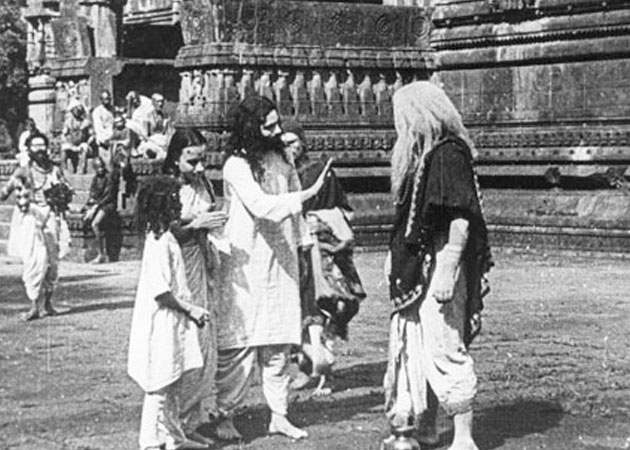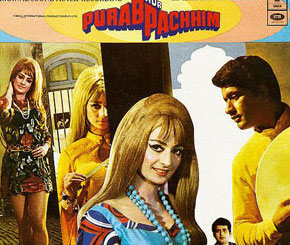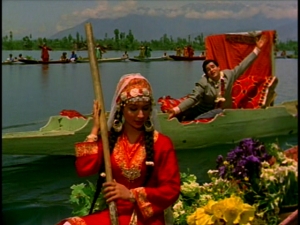[dropcap size=small]T[/dropcap]o say that movies are an inseparable part of any modern society would be like stating that wheels are pretty important for a car, and today’s India is no exception. Bollywood has grown on people’s minds. It dominates our vocabulary, our thought process and our social habits. Dialogues become everyday punch-lines, costumes become style statements and dance moves become social trends. But the most sublime aspect of any movie is the choice of locations. And today we are going to talk about exactly that.
[button color=”black” size=”big” alignment=”center” rel=”nofollow” openin=”samewindow” ]The Silent and Musical Talkies era[/button]

Through the ages, the focus of Bollywood has changed gradually but significantly. For quite some time after the birth of the Indian Cinema, movies were considered pure recreation. There was no concept of “average Indian viewer”. [highlight color=#00ABFF ]Movie watching was considered equivalent to gallivanting about in the streets, of a nature bordering on immoral.[/highlight] Thus, to attract viewers, the movie makers had to come up with incredible stories and characters nobody could relate themselves to. Filmmakers became the modern magicians, and in some cases vice versa.
Therefore, the early Bollywood movies were essentially fantasies or folklore, since “Raja Harishchandra” to the very first talkie “Alam Ara”. Films were shot mostly at random open sunlit places, with artificial props. [highlight color=#00ABFF ]Madras (now Chennai) and Bombay (now Mumbai) developed as centres for movie shoots. The camera reel was expensive and could not be wasted on filming the scenery.[/highlight] So any cheap abandoned building was a potential movie set.
[divider] [/divider]
[button color=”green” size=”big” alignment=”center” rel=”nofollow” openin=”samewindow” ]The Nationalist Wave[/button]

Then came the nationalist movement and as its part, various cultural and religious stories were revived on the silver screen. [highlight color=#00ABFF ]This period saw a drastic decrease in the creativity of the script and no improvement in the matter of locations.[/highlight] This trend continued until the decade of our independence. Although, there was a considerable focus now on the scenic beauty of the rural India in movies like “Do Bigha Zameen”, as way of instilling patriotic sentiments for our country.
[highlight color=#00ABFF ]“Mere desh ki dharati” became a national symbol.[/highlight]
[divider] [/divider]
[button color=”pink” size=”big” alignment=”center” rel=”nofollow” openin=”samewindow” ]The Dynamic 70s and 80s[/button]

Thenceforth came the MASALA wave. The original motive of movies to entertain was reinstated. Albeit this time, with the advent of the colour camera, filmmakers began exploring the horizons of cinematography. [highlight color=#00ABFF ]Beautiful locations emerged as a way to add another layer of abstraction to the movies.[/highlight] So basically, pictures finally became louder than words.
The filmmakers could now literally transport the conscious of the viewers outside of their daily stresses and worries and provide visual relief. [highlight color=#00ABFF ]Through celluloid, people could now explore the wonders of the natural world, which they did not have enough resources to physically visit.[/highlight]

Directors began scouting for locations which could provide the best background setting for their scripts. Not just that, locations began inspiring scripts, the foremost of such locations being Kashmir. “Kashmir ki Kali” and “Love in Kashmir” are two such notable examples. Even Hollywood and the British Cinema couldn’t resist the charms of the valley, “The Climb” and “The Razor’s Edge” are a couple of noteworthy titles shot in Kashmir.
The boathouses of the Dal Lake were absolutely perfect for intimate romantic scenes, the green hills of Gulmarg casted a playful spell on the visitors. [highlight color=#00ABFF ]The image of the lead hero and heroine entangled in each other’s arms, rolling down the slopes of the hill became a frequent visitor of the director’s minds.[/highlight] Also, who can forget Amitabh Bachchan’s melancholy monologue,”Kabhi Kabhi mere dil mein khayal aata hai…”. Till date, Kashmir has been the prime setting of numerous blockbusters like “Highway” and “Jab tak hai Jaan”.
Alas! The creativity of directors could not leave the orbit of Hill Stations, and we in the comfort of our homes roamed national tourist favourites like Ooty and Shimla to international locations like Switzerland (the reason we knew it exists before we knew that our politicians stash away their dirty cash there)
[divider] [/divider]
[button color=”blue” size=”big” alignment=”center” rel=”nofollow” openin=”samewindow” ]The Modern Era[/button]

[highlight color=#00ABFF ]Finally as we entered the 21st Century, the theme of movies dulled from the glittery dream world and over emotional family drama to the more gritty and realistic lives of people.[/highlight] A different viewpoint on the beauty of The Valley was presented with “Hero” and “Mission Kashmir”. Practical, responsible and relatable youth icons emerged in Bollywood from movies like “Dil Chahata Hai” and “Rang de Basanti”, and the locations gradually took an urban turn. The latter however captivated our perception of our nation with its vivid portrayal of North Indian cultural centres like Punjab, Haryana, Rajasthan, etc.

[highlight color=#00ABFF ]But this time, the shootings did not take place at abandoned isolated structures. Rather, the camera found its way into the thick of the common man’s life, finding the gem from a coal mine.[/highlight] Metros like New Delhi, Mumbai and even New York became the settings for cinema stories. Movies like “Delhi-6”, “A Wednesday!” and “New York” showed the lives of the middle class city dwellers in its barest and rawest form.
[divider] [/divider]
[button color=”red” size=”big” alignment=”center” rel=”nofollow” openin=”samewindow” ]Conclusion[/button]
Thanks to the movies like “Rockstar” and “Band Baaja Baaraat”, places of cultural significance in otherwise a culture-less modern city came into limelight. Jama Masjid, Chandani Chowk and the rest of the Purani Delhi emerged as new hangouts for the youngsters. Now, as we move into the second decade with more and more story oriented films round the corner, the future of the shooting location scene seems blurry.




